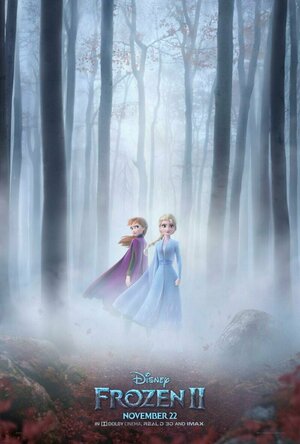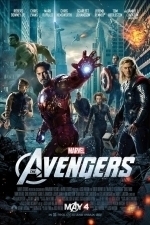Lee (2222 KP) rated Frozen II (2019) in Movies
Nov 25, 2019 (Updated Nov 25, 2019)
Following the events of the first Frozen movie, Arendelle is once again a calm, happy and carefree place. Elsa and Anna are close sisters once more. Anna and Kristoff are a couple, although in a running theme throughout the movie, Kristoff is now keen to try and propose to Anna. Meanwhile, some magic from Elsa means that Olaf now has a permafrost, no longer needing his own snow cloud and able to freely go around without fear of melting. He's also extremely keen to learn - becoming more thoughtful and aware of the world, asking existential questions, and sharing new found facts with his friends.
An early scene shows a young Elsa and Anna being told a bedtime story by their parents. The story involves an enchanted forest and their grandfather, who went to the forest as king in order to make peace with it's inhabitants, the Northuldra, and to sweeten the deal by building them a shiny new dam. But a betrayal caused the elemental forces of the forest - air, earth, fire and water - to become angered, resulting in a fierce battle and the entire forest being sealed for all time beneath a magical shield of mist. Clearly this story is being told in order to set the scene for a major plot point in this sequel, so it's not long before present day Elsa begins to hear voices - a mysterious siren, beckoning her with a beautiful melody. And when the terrifying elemental spirits strike the town of Arendelle, forcing its residents to flee for safety, she remembers the story we've just heard and heads off to the enchanted forest to look for answers and a resolution, closely followed by Anna, Kristoff, Sven and Olaf.
What follows is an epic adventure involving all of the main characters as they work together, or separately at times, to try and regain order and peace to this expanding world we're being introduced to. It becomes a quest to uncover the sisters ancestry and an attempt to undo damage caused by past generations with each character deals with their own personal transformation and growth. It's all beautifully animated, as you'd expect, full of peril, action and fun. And Olaf still manages to generate big laughs in pretty much every scene he's in!
Once again, Frozen 2 boasts an impressive soundtrack of songs. At least one is extremely powerful and catchy, knocking loudly at the door of 'Let It Go' in terms of memorability (admittedly, I've already listened to it a few times since leaving the cinema!), and there are more fun songs for Olaf to sing too. Kristoff comes up short though, getting dealt the worst of the songs, but that's not to say they're not still enjoyable.
Like Toy Story 4 earlier this year, Frozen 2 is a sequel that wasn't really necessary. But, as with Toy Story, it is still wonderful to be back in the company of such great characters. Having re-watched the original Frozen the day before seeing Frozen 2, I can honestly say that the sequel for me was just as enjoyable and entertaining as the first. Highly recommended.

Children's Bible Daily Prayers for Family & School
Book and Reference
App
Children's Prayer is an app for Christian families, teachers and catechists with kids of all ages....

Adobe Spark Video
Productivity and Photo & Video
App
*** App Store Editors’ Choice. #1 Best New App.*** Users say: "Brilliant and beautiful",...
Movie Metropolis (309 KP) rated Allegiant (2016) in Movies
Jun 11, 2019
The Maze Runner was a muddled first outing with the second, Scorch Trials faring much better and the same can be said for the Divergent series. The first film was at times, an incomprehensible mess, while its follow-up, Insurgent was a thrilling if CGI-heavy and overlong affair.
Allegiant marks the first of two films ending the moderately successful series, with Ascendant being released in June next year. But does this split conclusion harm it as much as it did for Mockingjay?
Allegiant picks up immediately after the end of its predecessor with Tris Prior (Shailene Woodley), her lover Four (Theo James) and a group of friends leaving their once safe-haven of a post-apocalyptic Chicago in order to find a world beyond the wall, populated by others once thought forgotten. What ensues will change their lives forever.
The cast is on form in this instalment with Woodley growing into the role perfectly. It’s true that she’s no Jennifer Lawrence, and many would see her as a budget Katniss Everdeen, but she plays the character with a confidence only matched by her rival in the genre. Theo James gets a much larger role here too, and this is welcome, given his pivotal part in the novels.
Elsewhere, Naomi Watts does her best Julianne Moore impression and clearly watched the latter’s performance in Mockingjay to prepare for an incredibly similar role. Jeff Daniels is a nice addition as the Bureau of Genetic Welfare’s leader, David, though again, his acting prowess feels a little wasted.
Robert Schwentke directs the film with a unique colour palate and visual flair. Scenes “beyond the wall” are stunning and glisten with a red lick of paint, a welcome change from the staid, grey and blue many directors continue to use in blockbusters. It’s very Total Recall-esque in these sequences and better for it.
Unfortunately, once the plucky group of teens leave the Martian-like “Fringe” behind, the CGI kicks up a gear. This is where things start to unravel somewhat and Schwentke throws effect upon effect at the screen until there is hardly any realism left. On the whole, they’re pretty decent, but there are a few lapses that stop the film dead in its tracks, especially towards the cliff-hanger conclusion.
It’s also far too long. Much like Mockingjay, splitting the final book was an exercise in cash-grabbing rather than giving fans of the novels what they want. At over two hours in length, Allegiant drags in places and means the final film, as a whole, will be around four hours.
Nevertheless, there is much to enjoy here. The story for newcomers is incomprehensible and some of the dialogue is downright laughable, but for those of us continuing the saga, it’s an epic adventure with some cracking visuals, good acting and an intriguing plot – despite a few convoluted moments.
Overall, Allegiant is a film hampered by its timing. The similarities to The Hunger Games are obvious throughout, from exactly the same dialogue in certain scenes, to similar sets and similar casting decisions. But, if you can forget all that, it’s a fun, if overlong ride
https://moviemetropolis.net/2016/03/13/a-for-effort-divergent-allegiant-review/
MichaelS (0 KP) rated Justice League (2017) in Movies
Feb 20, 2018
The plot only serves as a reason for these heroes to come together. So you can say that story is not a top priority. Character is the name of the game here, and on that level, the movie is gold. Each character is fully realized, with their own individual situation they need to grow from. Every hero is given his or her moment to shine as an individual. When they stand as a team, it's some of the best superhero action we've ever gotten.
The performances of the League members is spot on across the board. Every character is presented exactly the way they should be. Ben Affleck continues to prove all the doubters wrong, by giving us the best live action version of Batman we've ever seen. Right from the start you see how he demands fear from evildoers, but filled with hope for the good things in the world. Gal Gadot IS Wonder Woman. If there was any doubt left after her solo movie, it should be thoroughly erased now. She's strong in body, mind, and spirit. Jason Mamoa forever erases the idea of Aquaman being the wimpiest superhero. His "surfer dude" take on the character brings all the recklessness and abandon you'd expect from a beach bum. He's almost like a Spartan soldier that lives for the excitement of battle. Ezra Miller brings a youthful excitement of someone who is simply jazzed by what he, and others, can do with their abilities. He's almost the comic relief until you realize that the excited reactions he gives to everything is exactly what we would to if we were dropped in that situation.
SPOILER TERRITORY....skip to "END SPOILERS" if you don't want anything ruined
Although it should really come as no surprise to anyone, Superman does indeed return from the dead in this movie. Not only is that he's resurrected very cool, but the aftermath gives us the best fight scene of the film. Superman vs The Justice League. 'nuff said? I've always loved Henry Cavill as Superman, but now he owns the role. He has grown from a man filled with self doubt, trying to find his place in the world, to a man who now fully realizes who he is, and what purpose he serves to mankind. Lots of great Superman stuff in this movie, and that is the thing I'm most thankful for.
END SPOILERS
This is the most fun I've had with a superhero movie in a long time. It may not have the deepest plot, but that is fine with me, because this is truly a comic book come to life. It's full of the action and joyful spirit that the boy in me tuned into every weekend. Now, if the post credit scene in the movie delivers, it REALLY will be everything that the classic Challenges Of The Superfriends, and reduce me to that boy in pajamas again, cereal in hand, and a smile on my face.
Chris Sawin (602 KP) rated Gozu (2003) in Movies
Jun 21, 2019
Now on a quest to find where Ozaki has gone, Minami must deal with the bizarre individuals along the way like the innkeeper who shares her breast milk secrets, the white faced man who seems a little to eager to help him on his quest, and then there's that cow-headed creature that shows up in his room late one night. Minami soon realizes that his quest for his lost friend will not only be a long one, but a perplexing one as well.
Let's just say that if you're familiar with Takashi Miike's previous work like Ichi the Killer, Audition, and the banned from TV Masters of Horror episode, "Imprint," that Gozu fits in quite well with Miike's reputation. Gozu reels you in with the opening scene and then seems to snowball as the film goes on. It seems to dawdle through its duration as its weird individuals and events begin to pile up. A particular scene from The Shining ran through my mind throughout the film. The bear costume fellatio sequence. The Shining is known for being bizarre and unsettling and that is a perfect description of Gozu from the opening minutes of the film until the credits roll.
This is also the second film of Miike's involving breast milk that I've had the pleasure of seeing. He must associate that with weirdness or something, which it is. It's not necessarily something that sounds appealing, but once it starts happening it winds up being too horrifying and too unusual to turn away from. Seeing how far Miike is willing to push ideas in his films is one of the reasons people find his films enjoyable. That and originality. Despite the strangeness found in his films, finding something similar to his work is practically impossible. Originality is something that should be cherished when it's found in someone's work, but maybe that's just a personal opinion.
It's hard to label Gozu as a specific genre as it has elements from just about every genre that comes to mind. A dramatic horror with a little bit of mystery thrown in for good measure is the best I can do. The film is definitely a unique trip that definitely isn't for everyone. The most bizarre ideas roaming around in your brain right now probably don't compare to the last twenty or so minutes of Gozu. The events that unfold during that time are pretty jaw dropping. So if you're a Miike fan or are looking for something incredibly different (I'm talking way out there), then this comes highly recommended. There is no way that everyone who views this film will enjoy it, but the ending is incredibly memorable if the viewer can make it that far.
Darren (1599 KP) rated Black Christmas (2019) in Movies
Dec 13, 2019
Story: Black Christmas starts as we meet our sorority sisters Riley (Poots), Kris (Shannon), Marty (Donoghue), Jesse (O’Grady), Helena (Adams) and Fran (Morris) who are preparing for the Christmas break, with Riley having history with the alpha sorority, which never got dealt with by the authorities.
They decide to get revenge through song and soon find themselves getting picked of by a masked killer, where they need to find themselves fighting to survive.
Thoughts on Black Christmas
Characters – Riley is previously a victim of sexual assault by one of the rich college students, 3-years-later she is still dealing with the effects, being the big sister to the rest of the sisters and is one of the few that worries about the locations of the other girls. Kris has been on a crusade to get equality, she spends most of the time preaching about how men have it easy and mostly gets annoying. Marty is another member of the sorority and like Jesse, we don’t learn much more about any of the other girls.
Performances – Imogen Poots is a talent actress when she is given something to work with, she is the strongest of a weak story, where nobody comes off like they are giving a good acting performance.
Story – The story is meant to be following a group of sorority sisters that get picked off and attacked by a masked killer over the Christmas break. Well, where do we start to break this story down, first thing, this isn’t any sort of remake or sequel to either movie seen before, it uses the location of the house and one look at a death, don’t think this is a remake. Secondly, we spend more time trying to get the message over about men thinking they can walk all over women and the only good men in life are nervous wrecks around the women. Thirdly, this is meant to be a horror and doesn’t even know what tone to stick to. Finally, the trailer gives away everything. This is a social message that uses an existing horror franchise to try and get a point over, without using any sort of subtitle approach.
Horror/Mystery – The horror in this film is almost non-excitant, it tries to use the slow slasher traits early on, which show glimpses, only to go, ‘you know what, we want to do an action horror now’ by the end. The mystery is also poor, because we get zero potential suspects and the only person it could be is revealed in the trailer.
Settings – The college location is fine, though it is the weird college I have ever seen.
Special Effects – When it comes to the effects, we get basic horror ones, sadly, the film decides to hide away from showing any actual gore, even though the injuries are designed to show it.
Scene of the Movie – Nate grabs an axe.
That Moment That Annoyed Me – The girls leave a party at what they say is midnight, we cut to one that left early and it is suddenly 10.45, seriously can people not tell the time?
Final Thoughts – This is a very bad social message horror that spends more time banging you over the head with the message, than actually giving us a coherent story or any scare.
Overall: Social Message, without a scare.
JT (287 KP) rated The Avengers (2012) in Movies
Mar 10, 2020
The film opens as S.H.I.E.L.D. is mid evacuation after The Tesseract, an energy source of unknown potential, has activated. Loki (Tom Hiddleston) has plans to take over the world with a strong army and have everyone kneel before him, he’s cunning but “lacks conviction” as is pointed out by cult fan favourite Agent Coulson (Clark Gregg).
So, Nick Fury activates the Avengers initiative, pulling resource from Thor, Captain America, Iron Man, Black Widow, Hawkeye and of course Bruce Banner in order to stop the impending attack. The good thing about the Avengers is that no time needs to be spent setting the characters up, as given the previous films we know all about them and their powers. However, this gives more time for them to decipher each others egos.
Tony Stark feels like the team’s unofficial leader, brash and bold he has to contend with a number of personalities, remember he doesn’t play well with others. A great scene sees Thor, Captain America and Iron Man all come to blows but its hard to say if there was any clear winner.
Natasha Romanoff aka Black Widow and Clint ‘Hawkeye’ Barton who have popped up in previous films but neither had their own title struggle at times to fit in, but they are integral to the group and plot. However if there were not part of the assemble you wouldn’t miss them too much.
As for Bruce Banner, Weadon’s Hulk is probably the most realistic CGI transformation to date. Ang Lee’s looked ridiculous and Louis Leterrier’s Hulk looked liked he’d been pumped full of steroids as opposed to gamma radiation.
Weadon though achieved a great balance and with Mark Ruffalo stepping in as the green monster the Hulk had a lot of charisma in this, even having time for some humour. T.V. original big man Lou Ferrigno provided the voice so it all seemed like the Hulk was back.
The perfect villain – Loki
Hiddleston for me though was the stand-out here, as comic book villains go he brought so much to the role. It was a dark, composed and at times sinister portrayal of a man desperate for revenge and to be worshipped like the god he feels he deserves to be.
The films action sequences are second to none, with everything from the initial opening evacuation at S.H.I.E.L.D. to the climactic ending all choreographed to perfection. The only gripe is that it boarder lines on Transformers styled destruction, in which some parts are drawn out. I mean just how many Chitauri can one group of superheroes fend off?
Another post credits scene certainly would pave the way for a sequel, and given the film’s massive haul which is well in excess of $450m no one would stand in the way. It should pretty much be a forgone conclusion that the team will at some point reunite.

REACTION.CAM: Vlog Video Maker
Photo & Video and Social Networking
App
• "I really love this app. It makes me feel like I'm a pro YouTuber." - sammymenz • "Amazing...

Ezan Vakti Pro
Lifestyle and Reference
App
***Another first new feature: PRAYER ON TIME: Prayer constantly reminds. Until you say OK. ...





